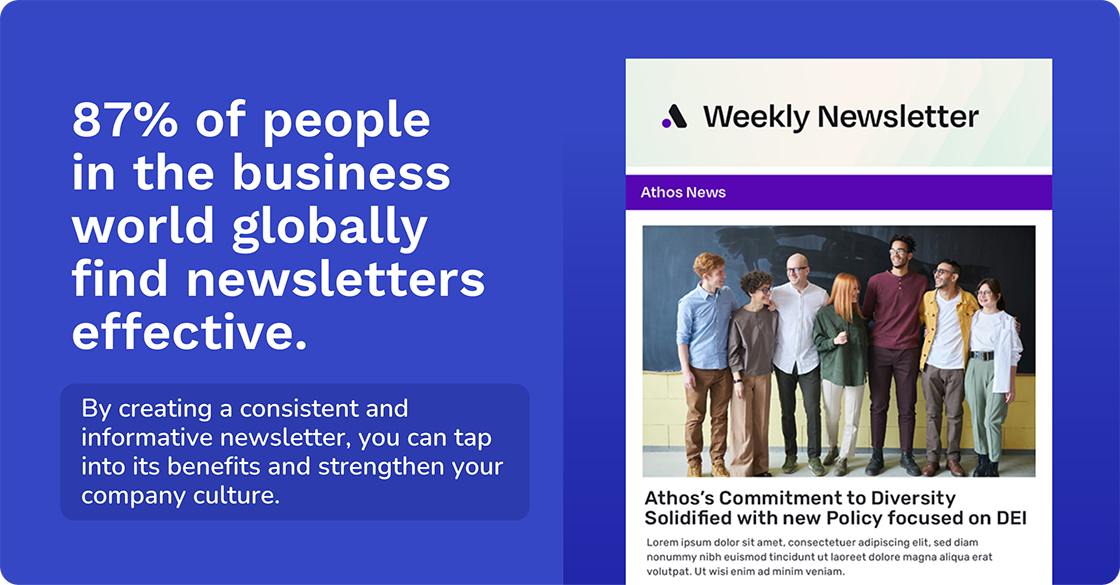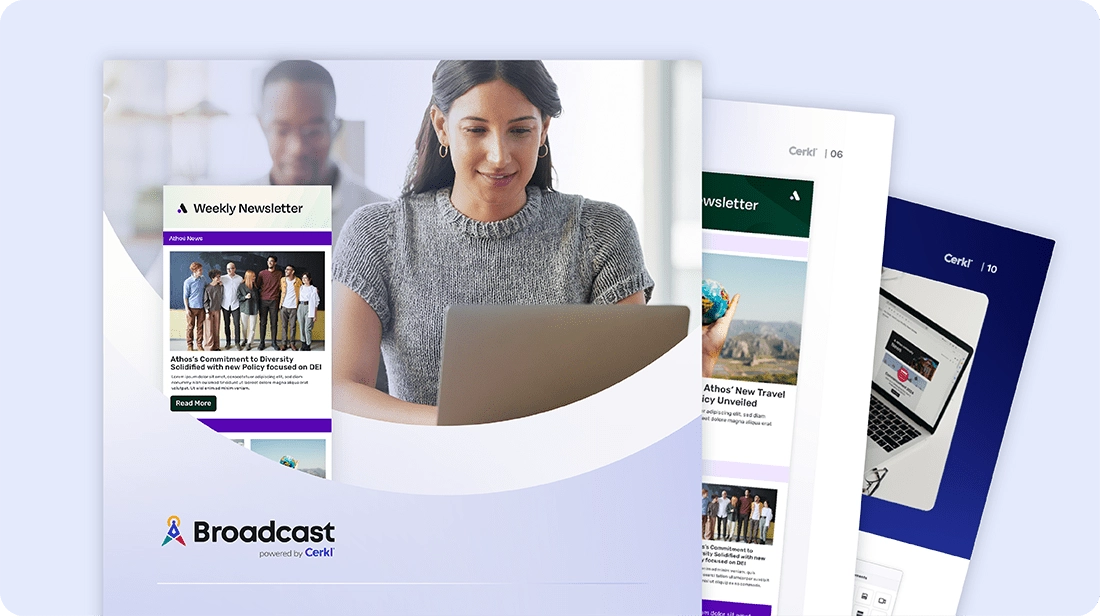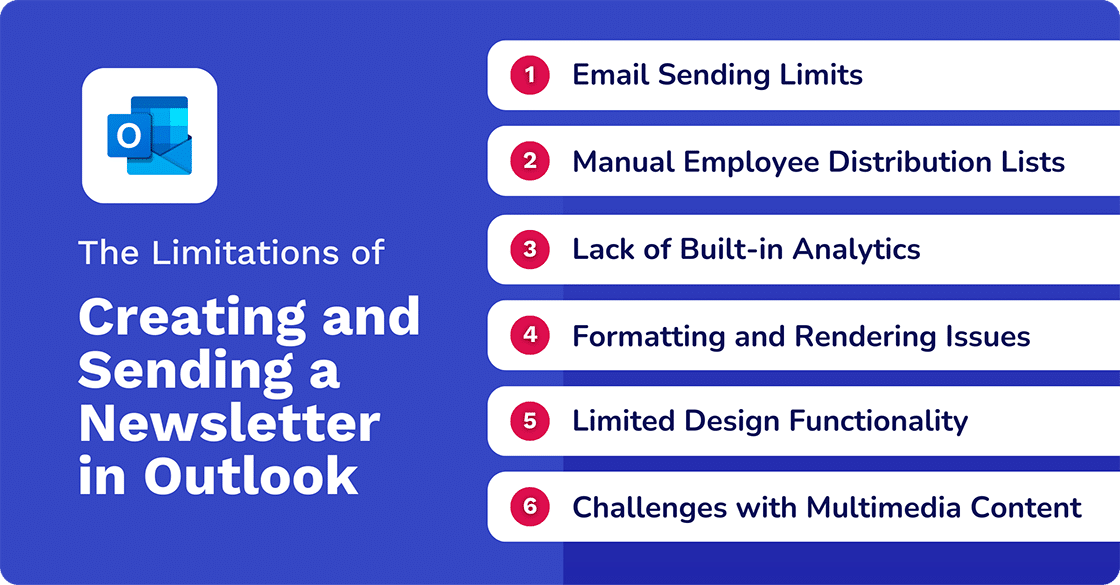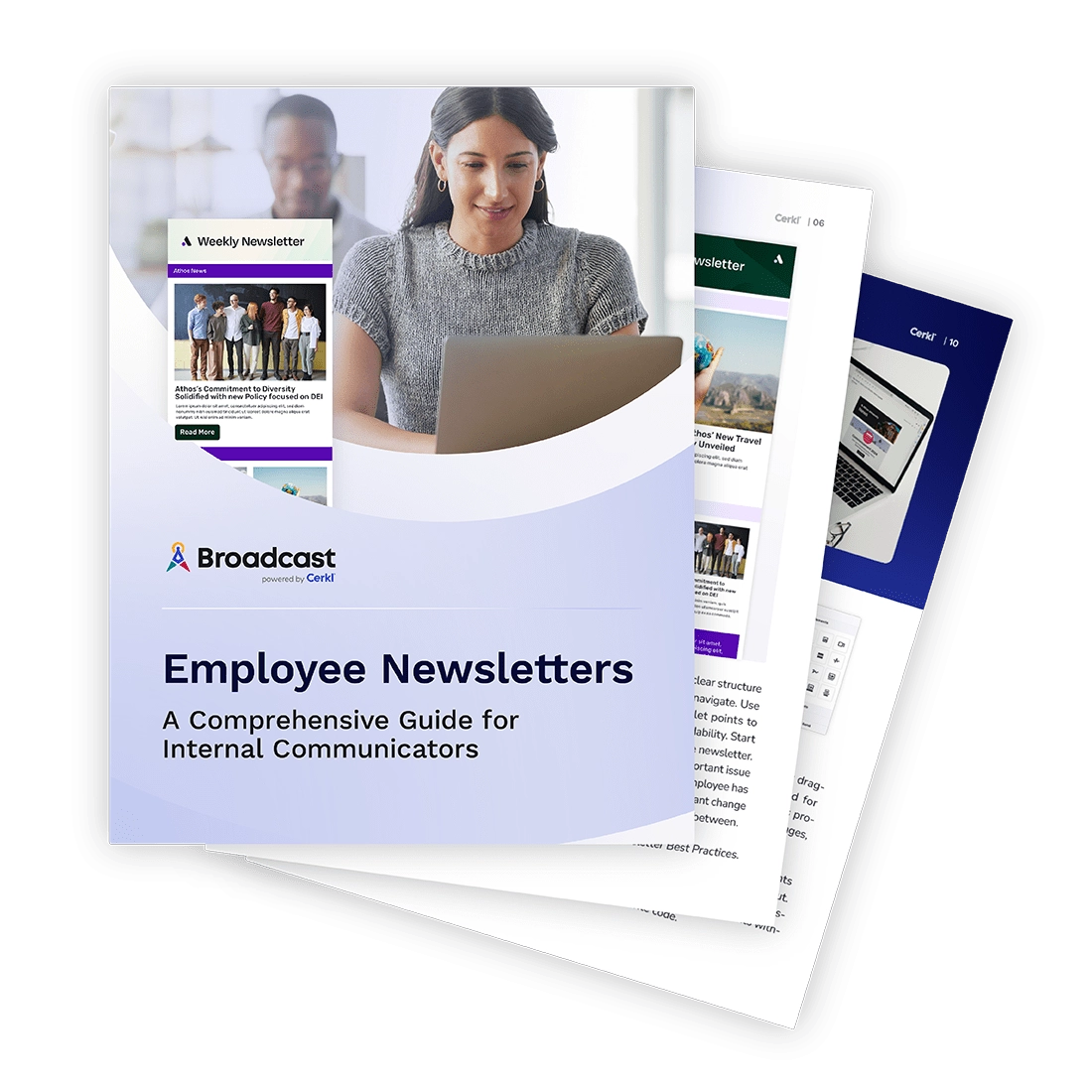There are many ways to distribute newsletters. We discuss how to send a newsletter in Outlook. It can be a good option, but there are limitations. Learn more right here.

.webp)
What are the key elements of an engaging employee newsletter? What should not be included in an employee newsletter? Find the answers to those questions and more best practices in our comprehensive guide on creating employee newsletters.
Access NowNewsletters are a cornerstone of internal communication. They foster a sense of community, keep employees informed, and align teams toward common goals. By delivering timely updates, recognizing achievements, and sharing company news, newsletters can significantly boost employee morale and productivity.
Newsletters also play a crucial role in aligning teams towards common goals. By keeping employees informed and connected, they contribute to a stronger company culture and improved employee satisfaction.
Recent studies underscore the importance of newsletters in the modern workplace. For example, Gallagher’s State of the Sector 2023/2024 report shows that 87% of people in the business world globally find newsletters effective. By creating a consistent and informative newsletter, you can tap into its benefits and strengthen your company culture.

While Microsoft Outlook might not be the most sophisticated platform for creating newsletters, it can be a handy email tool for sending out quick and informative updates to your team.
In this post, we’re going to walk you through the process of creating and sending a newsletter in Microsoft Outlook. We’ll include information on building a mailing list and how to attach a portable document format (PDF) version to satisfy those employees who prefer this option. We will also provide some alternatives for sending your email newsletters to ensure you get the right message to your internal audience.
In an era dominated by social media and instant messaging, email remains a powerful and reliable channel for delivering newsletters. With billions of emails sent daily, it's clear that email remains a cornerstone of digital communication.
Internal newsletters thrive in an email format. They offer a dedicated space to share important information, build relationships with recipients, and drive engagement. Unlike social media platforms with constantly changing algorithms, email provides direct access to your audience, ensuring your message reaches its intended recipients.
Moreover, email allows for customization and personalization. You can segment your audience and tailor content to specific groups, increasing relevance and effectiveness. Additionally, email offers measurable metrics, such as open rates and click-through rates, providing valuable insights into reader behavior.
According to Statista, as of April 18, 2024, the United States was the country with the highest number of emails sent daily, with almost ten billion. Employee newsletters are incorporated within this number. Their stats also show that by December 2023, more than 241 million emails were sent globally within each and every minute.
Before setting up and sending your newsletters via email, you need to create your newsletter content. It is vital to define the newsletter's purpose, target audience, and key messages. The content must be compelling, and it’s important to use strong subject lines, write clear and concise copy, and where possible, incorporate one or more relevant visual images.
Then, here’s what you will do when using Microsoft Outlook.
Guidelines for newsletters that will maximize employee commitment

Before hitting send, you'll need to create the content and decide on the overall look of your newsletter. The caveat is that you will be limited by what you can do using Microsoft Outlook when it comes to design. But don’t let this put you off.
These are some basic steps to follow when you create a newsletter in Outlook.
It should go without saying that you need to know how Outlook works. If you aren’t familiar with the program, get to know how it works before you start.
We’ve highlighted the importance of newsletter content. But be completely sure you have your content planned out and ready to use. You can do this in a separate word processing document like Microsoft Word or Google Docs, or even using presentation software like PowerPoint. Keep your content simple and concise for optimal rendering across devices. This will ensure better open rates.
In Outlook, click on "New Email" to create a new message. Use a clear and concise subject line that shows you are sending a newsletter. Here's where you'll paste your prepped content.
Break up the text with bullet points and headings to make your newsletter easy to scan. Visuals can enhance your newsletter, but use them judiciously. Too many images can slow down loading times and distract from your content. Aim for a balance of text and visuals to maintain reader engagement. White space can help to improve readability.
If you plan on sending similar newsletters in the future, you can save this email as a template for easy reuse. Click "File" -> "Save As" and choose "Outlook Template" from the "Save as type" dropdown. This is an optional step.
Preview your newsletter in different email clients like Microsoft Outlook, Gmail, Yahoo, and Apple Mail. This will ensure consistent display for all your recipients. Remember that different email clients render HTML differently, so it's essential to verify that your newsletter looks as intended across various platforms.
Create a distribution list for efficient sending. This might vary according to the personalization requirements for each newsletter. Often organizations create newsletters that are designed to focus on specific topics for different departments.
Use your distribution list to send the newsletter to your chosen audience. Check How to Send a Newsletter in Outlook below for more details.

An essential part of sending newsletters is having a list of recipients. This is what you need to do to create a dedicated contact group in Microsoft Outlook specifically for your newsletter distribution.
Alternatively, you can use the "To," "Cc," and "Bcc" fields when composing your newsletter, but this can become cumbersome for large groups.
Once your newsletter is crafted and your mailing list is ready, here’s how to send your newsletter quickly using Microsoft Outlook.
Some recipients might prefer a PDF version of your newsletter rather than one that is simply an email message. The other advantage of sending a newsletter as a PDF is that your design can be more creative, sophisticated, and visually appealing.
Here’s how to send a newsletter in Outlook by attaching a PDF version to your Microsoft Outlook email.
Guidelines for newsletters that will maximize employee commitment

Newsletters are a versatile communication tool. There are many different types of internal communication newsletters you can create and distribute via Outlook.
By following these steps and keeping your content clear and engaging, you can create effective newsletters using Microsoft Outlook to keep your employees informed and connected. Remember, while Outlook definitely has limitations for complex design, it can still be a valuable tool for internal communication.
Let’s look at some of the limitations you may face when creating and sending a newsletter in Outlook

Overall, while Outlook is a great tool for everyday email, it may not be the best choice for creating professional-looking newsletters.
The creation of any newsletter relies on a strong foundation of content development, and visual appeal, often facilitated by specialized software tools. When it comes to distribution this necessitates reliable email marketing software to manage subscriber lists, track performance, and ensure timely delivery.
Cerkl Broadcast won’t help you create newsletters, but it will help you deliver them dynamically using Email Blasts. You can’t go wrong.
If you want to consider an additional approach that will help you to personalize messages, News Digest is your answer.

St. Elizabeth Healthcare had been using a static employee newsletter PDF to communicate with its associates. Instead of a regular newsletter, they shifted to Cerkl Broadcast’s approach of distributing news content that matched their employees’ interests, locations, and positions.
By individualizing all the articles in your newsletter, you can use NewsDigest to distribute this content based on segments. This saves time for internal communicators. There’s no additional creation or scheduling… everything is automated.
Whichever option you choose, Broadcast enables you to measure your results with reliable analytics.
Creating an internal employee newsletter can be a challenge. But, if you follow a good framework of rules, you will find that you can achieve excellent results. We’ve created a comprehensive guide for creating newsletters just for you. You can download it now at no charge or obligation.

Guidelines for newsletters that will maximize employee commitment
How do I send an email newsletter in Microsoft Outlook? To send an email newsletter in Outlook, create a new email, design your content with formatting and images, and send it to a distribution list of recipients.
How do I send a PDF newsletter in Outlook? To send a PDF newsletter in Outlook, create a PDF of your newsletter and attach it to a new email.
Does Outlook have templates for newsletters? Outlook offers basic templates, but they are limited. For more advanced designs, consider using third-party tools or creating your own template. It’s not difficult.
How do I insert a newsletter in the body of an email? All you do is generate or cut and paste the text you want with headings and images. However, inserting a newsletter in the body of an email is generally not recommended due to formatting issues and potential size limitations. When emailing via Microsoft Outlook, it's better to attach the newsletter as a PDF.

Guidelines for newsletters that will maximize employee commitment